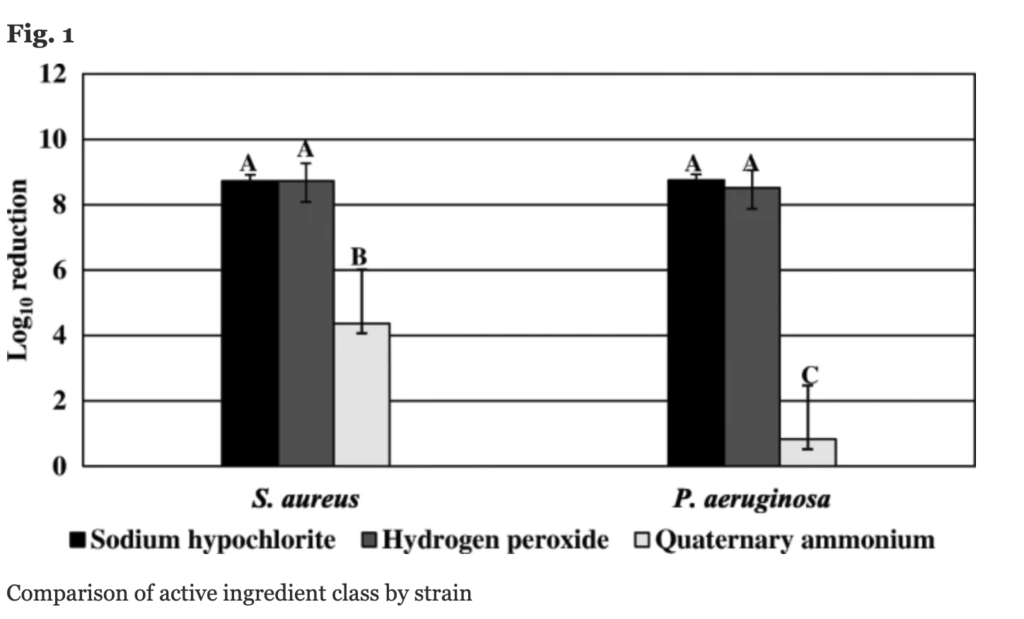Frequently Asked Questions
Where did this list come from?
The original source of this list (“List N”) is the Environmental Protection Agency. The list includes disinfectants approved for use on SARS-CoV-2, the virus that causes COVID-19. Also included on the list are products that are effective against harder-to-kill viruses than SARS-CoV-2. EPA has been making updates ever since the list was launched in March 2020. We add “Safer” and “Increased Risk” information based on the Active Ingredients in the product.
Why make another version of “List N?”
The list on our website adds some features that the EPA didn’t offer:
- “Safer” or “Increased Risk” designation
- Fast search (just press Find on your browser)
- Fast filtering. (For instance: Filter to find all the Safer disinfectants that are used in Healthcare on Hard Non-porous Surfaces.)
- Some charts
Why “Safer” and not “Safe”
Labels on disinfectant show the active ingredients that kill the target pathogen. But disinfectants also contain inert ingredients, and manufacturers are not required to reveal those ingredients. When we designate a disinfectant as “Safer” we are suggesting that they are likely safer than the ones that we know definitely contain ingredients with negative human health impacts. In essence, we are evaluating the relative harm of disinfectants based on what we know.
Why “Increased Risk” if EPA approved it?
Increased Risk signals the degree to which a chemical substance, or a particular mixture of substances can damage an organism. EPA has approved “List N” disinfectants for their ability to kill the Covid-19 virus, one particular organism. We use the term “Increased Risk” to identify those “List N” products which contain chemicals that are known to have damaging health impacts to human respiratory and immune systems—our systems which are especially vulnerable to COVID-19.
Which disinfectant chemicals are safer?
- 1,2-Hexanediol
- Capric acid
- Citric acid
- Dodecylbenzenesulfonic acid
- Ethanol (Ethyl alcohol)
- Hydrogen peroxide
- Isopropanol (Isopropyl alcohol)
- L-Lactic acid
- Sodium carbonate
- Sodium carbonate peroxyhydrate
- Sodium chloride
- Tetraacetyl ethylenediamine
- Thymol
See more information at this blog post
Which disinfectant chemicals are increased-risk to people?
These disinfectants are increased-risk:
- Ammonium bicarbonate
- Ammonium carbonate
- Chlorine dioxide
- Glutaraldehyde
- Glycolic acid
- Hydrochloric acid
- Hydrogen chloride
- Hypochlorous acid
- Iodine
- Octanoic acid
- Peroxyacetic acid (Peracetic acid)
- Peroxyoctanoic acid
- Phenolic
- PHMB
- Potassium peroxymonosulfate
- Quaternary ammonium
- Silver
- Silver ion
- Sodium chlorite
- Sodium dichloroisocyanurate
- Sodium dichloroisocyanurate dihydrate
- Sodium hypochlorite
- Triethylene glycol
See more information at this blog post
What does the column Follow_directions_for_this_virus mean? Why are viruses other than the human coronavirus listed in that column?
This column shows the harder-to-kill viruses pathogens than the human coronavirus. Products qualify for the emerging viral pathogen claim by showing that it works against the listed harder- to-kill virus pathogen. Therefore, if the contact time for this harder-to-kill virus is followed, EPA expects the product to be effective against SARS-CoV-2 (the coronavirus that causes COVID-19) on surfaces. You can also find this information on the product label. It’s important to note that EPA expects that all products on the list will be effective against SARS-CoV-2 (COVID-19). Reference
Are safer products hard to find?
Safer products are often available on the store shelves (or internet shops) right next to disinfectants with increased-risk ingredients. In many cases, the same company produces some disinfectants with increased-risk, and others with safer active ingredients.
Do safer disinfecting products work as well as increased-risk ones?
In some cases they actually work better. For instance in this paper, hydrogen peroxide was on par with bleach… but 2 to 5 times more effective than quaternary ammonium compounds in battling two significant hospital bacterial infections. .
 Lineback, C.B., Nkemngong, C.A., Wu, S.T. et al. Hydrogen peroxide and sodium hypochlorite disinfectants are more effective against Staphylococcus aureus and Pseudomonas aeruginosa biofilms than quaternary ammonium compounds. Antimicrob Resist Infect Control 7, 154 (2018).
Lineback, C.B., Nkemngong, C.A., Wu, S.T. et al. Hydrogen peroxide and sodium hypochlorite disinfectants are more effective against Staphylococcus aureus and Pseudomonas aeruginosa biofilms than quaternary ammonium compounds. Antimicrob Resist Infect Control 7, 154 (2018).